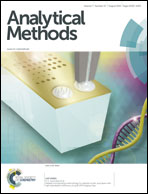Os-complex-based amperometric bienzyme biosensor for continuous determination of lactate in saliva
Abstract
An amperometric biosensor, constructed through a specific design featuring a bienzyme doped sol–gel and an Os-complex mediator layer, capped with electropolymerized polyphenol semipermeable membranes, is presented for lactate quantification in saliva. The new enzymatic biosensor exhibits impressive linear and low response times in a phosphate buffer solution of pH 7.0, and a linear dependence of the catalytic current upon lactate bulk concentration is obtained between 0.1 and 1.0 mM (r = 0.997). A detection limit of 0.013 mM can be calculated as three times the standard deviation of the blank signal divided by the sensitivity of the sensor. The selectivity of the biosensor is evaluated by adding common interferent species such as ascorbic acid and uric acid to 0.2 mM lactate; current responses for the interferents are nearly negligible compared to that of the lactate, indicating excellent discriminatory selectivity. The lactate biosensor presents remarkable operational stability in 0.2 mM lactate over a 2 h period and good repeatability in a carry-over test by alternating lactate concentrations. The successful application to whole human saliva samples for continuous monitoring of lactate dynamics makes the amperometric bienzyme biosensor hold considerable promise for diverse biomedical and fitness applications.


 Please wait while we load your content...
Please wait while we load your content...